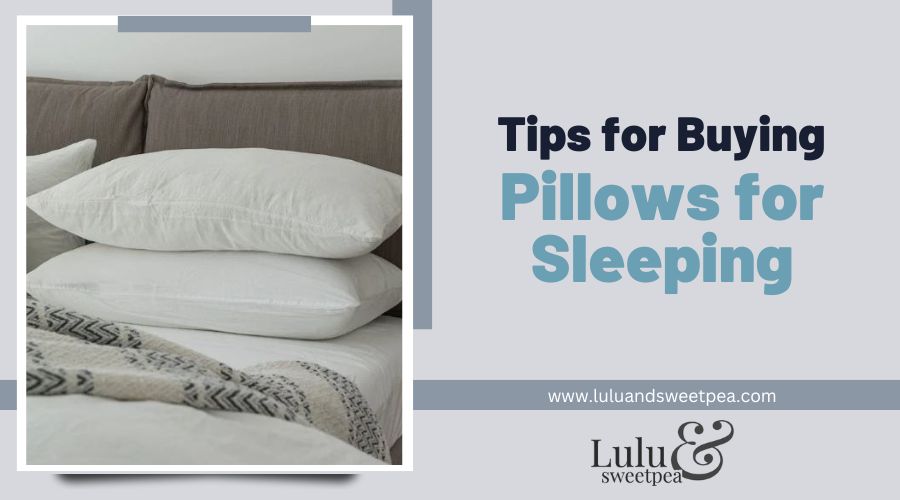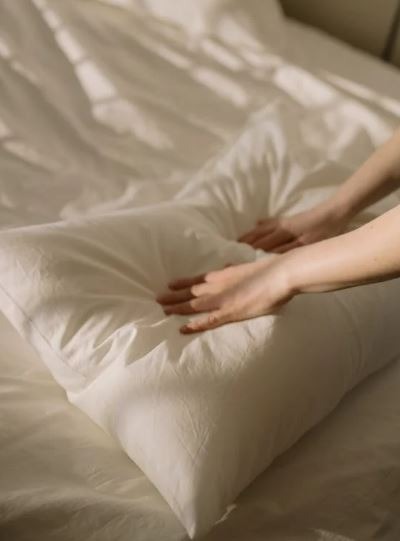Sleeping well is vital for healthy mental and physical wellbeing. The key to a restful night’s sleep is a soft pillow. Pillows are available in a range of sizes, materials, and levels of comfort. If you aren’t sleeping on the best mattress for you, it could disrupt your sleep cycles and prevent you from obtaining quality rest.
Before purchasing a pillow, do your mind and body a favor by conducting research to decide which one is best. This buying guide will provide you with all the necessary information to make the best choice.
Why your pillow is important?
A healthy resting position is essential for restful sleep night after night and waking without pain or stiffness. Your pillow supports a good sleeping position. What does that posture look like? A body that is aligned from the knees and hips, through the spine, to the chest, shoulders, and head and neck.
If your neck and shoulders are not adequately supported, or if they are propped at an angle that causes twisting, craning, or crunching, this throws your spine and body out of alignment, causing strain, discomfort, and sleeplessness in your neck, shoulders, and back.
As with your mattress, comfort and support are crucial factors to consider while buying a pillow. The optimal pillow for you is one that supports your head, neck, and shoulders and complements your mattress.
Factors to Consider Before Buying a Pillow
1. Consider your sleeping position prior to shopping
As with mattresses, consider how you sleep when purchasing pillows. The greatest pillow for reducing neck pain and ensuring a restful night’s sleep is one that aligns your spine in a neutral posture and is made of a material you find comfortable. A simple fit test: when sleeping on your back, your neck should not tilt in any way.
According to Dr. Jaspal R. Singh M.D., co-director of the Center for Comprehensive Spine Care at Weill Cornell Medicine, side sleepers need a thick, firm cushion to “maintain their ears in line with their shoulders” to prevent their neck from spreading in either way while they sleep on their side.
Those who sleep on their stomachs should use a soft, thinner cushion so that their neck remains in a neutral position. Additionally, some experts suggest placing a pillow beneath the shoulder for appropriate spine alignment.
Back sleepers should choose a mattress with a medium thickness that keeps their neck aligned without causing their head to arch forward.
If you change positions throughout the night, you should search for a pillow with movable stuffing. As you toss and turn, you will be able to locate the optimal position.
2. Be particular about stiffness
Do you primarily sleep on your back, side, or stomach? If you sleep on your side, you need a pillow that fills in the space between the bed and your upper back and shoulder blades. According to Joel Press, M.D., chief physiatrist at the Hospital for Special Surgery in New York, it will help keep your neck straight with your spine rather than inclined to prevent strain. Due to the curvature of their upper backs and shoulder blades, back sleepers require flatter pillows. If you sleep on your stomach, a small pillow is sufficient to maintain the natural curvature of your neck.
And do not rely solely on the manufacturer’s label to determine the firmness of a cushion. To determine the genuine firmness of a cushion, press down on it. If possible, shake, fluff, squeeze, and even lay on the item you’re purchasing to get a feel for it. Check pillows with a loose filling, as opposed to a slab of foam, to see if they retain their shape after being fluffed and if there are bumpy places. You desire a cushion with consistent shape and density.
3. Understand your mattress
Your pillow and mattress must function in tandem to support your body while you sleep. If your mattress is soft, you need a thinner pillow. This is true whether you sleep on your back or side. Test engineer Chris Regan, who coordinates Consumer Reports’ pillow tests, explains that a softer mattress often allows the body to sink into it, resulting in a smaller space between the head and the mattress. Firmer mattresses prevent you from sinking in as much, creating a bigger space between the mattress and your neck, necessitating a thicker pillow.
4. Consider ventilation
Being hot and sweaty is not conducive to a restful night’s sleep. You need a pillow that allows air to circulate through as opposed to one that traps heat. As a general rule, the more dense the pillow filling, the less breathable it will be for the head and neck. The pillows that remained coolest in our tests were constructed of polyester or shredded foam. Single-piece foam mattresses were the least breathable.
What about pillows with gel cushions for cooling? In our studies, these pillows initially gave our human participants a slightly refreshing feeling, but this quickly wore off, and they were among the least breathable pillows we tested.
5. Examine the care label
Some labels may specify that only the cover can be cleaned, indicating that not every cushion can be laundered. The majority of the pillows we examine are typically machine-washable on a cold setting. According to The Asthma and Allergy Foundation of America, if you have an allergy to dust mites, you must wash your pillow once a month in hot water (130° F) to kill any bugs. What about swapping out a pillow? National Sleep Foundation suggests replacing your pillow every one to two years.
6. Inquire regarding return policies and trial periods
Cushions can be expensive: Many of the better pillows in our tests ranged in price from $60 to $80. Before purchasing a pillow, determine if you can test it at home for a period of time. Retailers such as Walmart and Sam’s Club give a complete refund with a receipt within a certain time frame. Some manufacturers, including Casper and Coop Home Goods, provide a 100-night sleep trial during which you can return the pillow for a refund if you’re not satisfied.
Considerations for Purchasing Pillows
1. Material – When selecting a pillow, there are a variety of various materials from which to choose. As with mattress kinds, choosing the proper type or material for a pillow depends on your individual preferences and demands.
2. Polyester – Polyester-filled pillows are the most popular and affordable on the market. They are frequently referred to as poly-fill pillows and are popular due to their low prices. However, because they can be produced from low-quality material, they tend to lose their form rapidly, meaning you will need to replace them more frequently.
3. Memory Foam – Since the material conforms to the body, memory foam pillows are ideal for all sleeping positions. Whether you sleep on your side, your back, or somewhere else entirely, memory foam will make you feel comfortable. High-density memory foam is not very breathable, so it’s not the ideal option if you tend to sleep overheated.
4. Latex – Latex cushions are resilient, formable, biodegradable, and breathable. They are ideal for overheated sleepers who require a cooling cushion to sleep peacefully. However, latex is a common allergen3, so ensure you are not allergic prior to purchase.
5. Down – Made from the delicate fibers near the skin of a goose, swan, or duck, down is one of the market’s most coveted pillow materials. It is formable and offers above-average head and neck support, while being lightweight and plush. However, down retains body heat and harbors more allergens, such as dust mites, than other textiles, so it’s not ideal for everyone.
6. Down Alternative – Down alternative is a synthetic version of down that is typically polyester that mimics the feel of down. Hypoallergenic, down-alternative pillows are an excellent option for allergy sufferers who enjoy the cushiony feel of down pillows. These pillows are frequently less expensive than genuine down pillows because they are produced from polyester, but this also means that they can get lumpy and need to be replaced.
7. Feather – Possibly the fluffiest and softest pillows are made from feathers. While feather pillows are light and soft, they are exceptionally supportive and formable. Regular fluffing is required for feather pillows to retain their loftiness. They can be challenging to clean, but they are inexpensive, so replacing them won’t put you in the red.
8. Cotton-Cotton pillows are adaptable, meaning they are suitable for the vast majority of sleepers. They are hypoallergenic and breathable, however they must be cleaned frequently and do not curve well. Cotton pillows are a cheap solution for folks with allergies to synthetic materials.
9. Gel – Gel pillows are comprised of gel and another substance, such as memory foam, and are breathable and easy to maintain. The gel material is solid, whereas the foam (or other material) is soft. Gel pillows may be too hard for some sleepers, but give them a try if you are allergic to other pillow materials or if you sleep hot, as some gel layers claim to keep sleepers cooler during the night.
10. Size – Pillows are available in a number of sizes. Most sleepers will be satisfied with a standard-sized pillow; but, if you move much during sleep, you may require a larger pillow. If you have a king-size bed, a standard-sized pillow may appear awkwardly little.
Standard cushion dimensions are:
Normal: 20 by 26 inches
Standard: 20 x 30 inches
King dimensions: 20 x 36 inches
11. Firmness – Consider whether you predominantly sleep on your back, side, or stomach. Side sleepers should select a pillow that is both fluffy and firm, whilst back sleepers and stomach sleepers should select pillows that are not so hard as to cause them to strain their necks while sleeping. While purchasing a pillow, squeeze it to determine its firmness.
12. Price – No matter your budget, there is a pillow on the market that will meet your needs. Pillows are accessible at nearly every price tier. Pillow prices range from less than $10 to over $1,000, with the majority costing less than $200.
To summarize
Getting a good night’s sleep is dependent on a number of circumstances. In addition to having a comfortable mattress and linens, climate control, lighting, and mental distractions all impact the quality of your sleep. A supportive pillow can make all the difference in facilitating a restful night’s sleep. Therefore, it is essential to pick one that fits your sleeping position and personal preferences.



